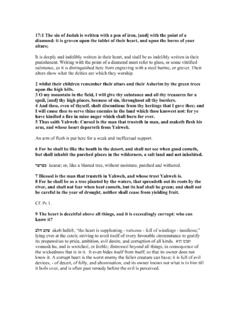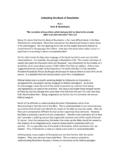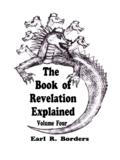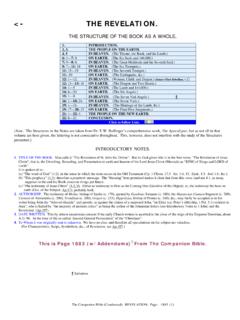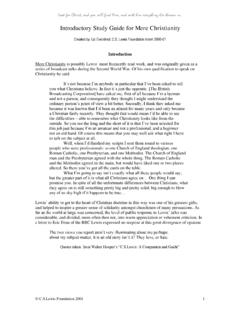Transcription of Revelation: An Exegetical Study of the Greek Text
1 revelation : An Exegetical Study of the Greek TextI. Purpose: An examination of the Greek text of the book of revelation designed tosupply the student with a general knowledge of the book and its interpretive questions. II. Course Requirements: To accomplish the above mentioned goal the student will berequired to read a commentary on revelation , as well as the attached notes. These notesare based on Robertson s Word Pictures in the New Testament. Then the studentwill be required to answer, in essay form, the questions found at the end of the working knowledge of Greek is also a prerequisite for the Textbooks: Select a commentary on revelation for your textbook. Possibilities wouldbe the two volumes by Robert L. Thomas: revelation 1-7: An Exegetical Commentaryand revelation 8-22: An Exegetical Commentary, or the two volumes in the InternationalCritical Commentary by Charles, revelation I and II. Single volume commentariesinclude Ford's revelation , which is part of the Anchor Bible Commentary or LeonMorris' revelation , part of the Tyndale New Testament Commentary.
2 There are manyothers. It is to your advantage as a student to get more than one commentary, preferrablyfrom several theological perspectives. These commentaries can be ordered from TheCampus Bookstore. Introduction The book of revelation is perhaps the most misunderstood, and misused of allBiblical books. It has been ignored or misapplied by thousands of Christians forthousands of years. It has been interpreted (or perhaps better, misinterpreted) and made tosay things that would, no doubt, horrify John the Seer. The book has suffered such misunderstanding for a variety of reasons. The primaryreason is that many interpreters have failed to take seriously the first verse of the verse is the key to the entire text. The second reason that the book has been misunderstood is that interpreters havefailed to take into account the historical situation of the text. One cannot rightly interpretany material if one does not know why and when it was written. Now it is an understatement to say that revelation can be interpreted in a variety ofways; some interpret it as a map of the distant future.
3 Others see it as a description of thewhole of human history. There are premillenial interpretations, post millenial, and a-millenial. All of these views compete for followers. The problem, in my view, with allthese attempts, is that they fail to take seriously the first verse, which, as I have alreadysaid, is the key to the whole book . That is, in short; the book is an unveiling of Jesus. Thebook is about Jesus! Who is he, and what has he done? That is what the book is is what the first verse says! Now we must discover the historical situation which gave birth to the book . At theend of the first century the Church (in certain areas) was suffering persecution. Theemperor was demanding worship and the Christians were refusing to do so. Inconsequence the emperor was killing some and seizing the property of others. Here ishow it worked: In each village and town, as well as the larger cities, a representative of the emperormade an appearance each year. The citizens of the region were required to bring theirtaxes and present them as an offering to the emperor.
4 They were also asked to swear anoath to the emperor and vow to pray to him yearly. This the Christians could not do. So,as punishment, they were made to forfeit their property. If they continued to refuse theycould be (and some were) killed. In the midst of this dreadful situation the Church was asking, where is Jesus. Has heabandoned us? Does he no longer care for us? John gives answer. As we make progressin discussing the text of the book the historical situation will be brought to bear in orderto enlighten the text. Thus the book was written at the end of the first century in Asia Minor by an exiledChristian who had lost his property and his citizenship for refusing to worship :1 jApokavluyi" jIhsou' Cristou' h}n e[dwken aujtw'/ oJ qeoV" dei'xai toi'" douvloi"aujtou' a} dei' genevsqai ejn tavcei, kaiV ejshvmanen ajposteivla" diaV tou' ajggevlouaujtou' tw'/ douvlw/ aujtou' jIwavnnh/, Apokalupsis, from apokalupto, old verb, to uncover, to unveil. In the Epistlesapokalupsis is used for insight into truth (Eph_1:17) or for the revelation of God or Christat the second coming of Christ (2Th_1:7; 1Pe_1:7).]
5 It is interesting to compareapokalupsis with epiphaneia (2Th_2:8) and phanerosis (1Co 12:7). The precise meaninghere turns on the genitive following. Hort takes it as objective genitive ( revelation aboutJesus Christ) and in this he is most certainly correct. The revelation is about Jesus, notabout the future or the past apart from Him. dei genesthai en tachei. Second aoristmiddle infinitive of ginomai with dei. See this same adjunct (en tachei) in Luk_18:8;Rom_16:20; Rev_22:6. It is a relative term to be judged in the light of 2Pe_3:8 accordingto God s clock, not ours. As one commentator notes, rightly, Jesus is the medium of allrevelation (Moffatt).2 o}" ejmartuvrhsen toVn lovgon tou' qeou' kaiV thVn marturivan jIhsou' Cristou' o{saei\den. Emarturesen is an epistolary aorist here, referring to this book . ton logon tou theouSubjective genitive, given by God. The prophetic word as in Rev_1:9; Rev_6:9;Rev_20:4, not the personal Word as in Rev_19:14. 3 Makavrio" oJ ajnaginwvskwn kaiV oiJ ajkouvonte" touV" lovgou" th'" profhteiva"kaiV throu'nte" taV ejn aujth'/ gegrammevna, oJ gaVr kairoV" ejgguv".
6 Ho anaginoskon . Present active singular articular participle of anaginosko (as inLuk_4:16). Christians in their public worship followed the Jewish custom of publicreading of the Scriptures (2Co_3:14.). The church reader (anagnostes , lector) graduallyacquired an official position. John expects this book to be read in each of the sevenchurches mentioned (Rev_1:4) and elsewhere. kai terountes . Present active participle oftereo , a common Johannine word (1Jo_2:4, etc.). Cf. Mat_7:24. The content of theApocalypse is not merely prediction; moral counsel and religious instruction are theprimary burdens of its pages (Moffatt). ho gar kairos eggus. Reason for listening andkeeping. On kairos see Mat_12:1, time of crisis as in 1Co_7:29. How near eggus (athand) is we do not know any more than we do about en tachei (shortly) in Rev_1:1. Seealso Mark 13 jIwavnnh" tai'" eJptaV ejkklhsivai" tai'" ejn th'/ jAsiva/: cavri" uJmi'n kaiV eijrhvnhajpoV oJ w]n kaiV oJ h\n kaiV oJ ejrcovmeno" kaiV ajpoV tw'n eJptaV pneumavtwn a} ejnwvpiontou' qrovnou aujtou' These seven cities were the best points of communication with seven districts (Ramsay).
7 There is the one Holy Spirit with seven manifestations here to the seven churches. Thereare not 7 Holy Spirits!5 kaiV ajpoV jIhsou' Cristou', oJ mavrtu", oJ pistov", oJ prwtovtoko" tw'n nekrw'n kaiVoJ a[rcwn tw'n basilevwn th'" gh'". Tw'/ ajgapw'nti hJma'" kaiV luvsanti hJma'" ejk tw'naJmartiw'n hJmw'n ejn tw'/ ai{mati aujtou', The use of martus of Jesus here is probably to the witness (Rev_1:1) in this book (Rev_22:16.), not to the witness of Jesus before Pilate (1Ti_6:13). ho prototokos ton nekron . A Jewish Messianic title (Psa_89:27). This indicates that John is addressing aJewish audience- or at least a congregation very familiar with Jewish Scripture. aorist active participle of luo (Aleph A C), though some MSS. (P Q) read lousanti(washed), a manifest correction. Note the change of tense. Christ loosed us once for all,but loves us kaiV ejpoivhsen hJma'" basileivan, iJerei'" tw'/ qew'/ kaiV patriV aujtou', aujtw'/ hJ dovxakaiV toV kravto" eij" touV" aijw'na" (tw'n aijwvnwn): ajmhvn.]}
8 The idea here is that Christians are the true spiritual Israel in God s promise to Abrahamas explained by Paul in Gal 3; Rom 9. 7 jIdouV e[rcetai metaV tw'n nefelw'n, kaiV o[yetai aujtoVn pa'" ojfqalmoV" kaiV oi{tine" aujtoVn ejxekevnthsan, kaiV kovyontai ejp= aujtoVn pa'sai aiJ fulaiV th'" gh'".naiv, ajmhvn. Compare the manifestation of God in the clouds at Sinai, in the cloudy pillar, theShekinah, at the transfiguration (Vincent). exekentesan . First aorist active indicative ofekkenteo , late compound (Aristotle, Polybius, lxx), from ek and kenteo (to stab, to pierce),in , only here and Joh_19:37, in both cases from Zec_12:10, but not the lxx text(apparently proof that John used the original Hebrew or the translation of Theodotion andAquila). kopsontai. Future middle (direct) of kopto , old verb, to cut, they shall cutthemselves, as was common for jEgwv eijmi toV a[lfa kaiV toV w\, levgei kuvrio" oJ qeov", oJ w]n kaiV oJ h\n kaiV oJejrcovmeno", oJ pantokravtwr.]]}
9 Only here and Rev_21:5. is God introduced as the speaker. 9 jEgwV jIwavnnh", oJ ajdelfoV" uJmw'n kaiV sugkoinwnoV" ejn th'/ qlivyei kaiV basileiva/kaiV uJpomonh'/ ejn jIhsou', ejgenovmhn ejn th'/ nhvsw/ th'/ kaloumevnh/ Pavtmw/ diaV toVnlovgon tou' qeou' kaiV thVn marturivan jIhsou'. Patmos is a rocky sparsely settled island some ten miles long and half that wide, one ofthe Sporades group in the Aegean Sea, south of Miletus. The present condition of theisland is well described by W. E. Geil in The Isle That Is Called Patmos (1905). HereJohn saw the visions described in the book , apparently written while still a prisoner therein ejgenovmhn ejn pneuvmati ejn th'/ kuriakh'/ hJmevra/ kaiV h[kousa ojpivsw mou fwnhVnmegavlhn wJ" savlpiggo" Deissmann has proven (Bible Studies, p. 217f.; Light, etc., p. 357ff.) from inscriptionsand papyri that the word kuriakos was in common use for the sense imperial as imperialfinance and imperial treasury and from papyri and ostraca that hemera Sebaste (AugustusDay) was the first day of each month, Emperor s Day on which money payments weremade (cf.)]
10 1Co_16:1.). It was easy, therefore, for the Christians to take this term, alreadyin use, and apply it to the first day of the week in honour of the Lord Jesus Christ sresurrection on that day (Didache 14, Ignatius Magn. 9).11 legouvsh": o} blevpei" gravyon eij" biblivon kaiV pevmyon tai'" eJptaV ejkklhsivai",eij" [Efeson kaiV eij" Smuvrnan kaiV eij" Pevrgamon kaiV eij" Quavteira kaiV eij"Savrdei" kaiV eij" Filadevlfeian kaiV eij" Laodivkeian. 12 KaiV ejpevstreya blevpein thVn fwnhVn h{ti" ejlavlei met= ejmou', kaiV ejpistrevya"ei\don eJptaV lucniva" crusa'" 13 kaiV ejn mevsw/ tw'n lucniw'n o{moion uiJoVn ajnqrwvpou ejndedumevnon podhvrh kaiVperiezwsmevnon proV" toi'" mastoi'" zwvnhn crusa'n. pros tois mastois. Old word for breasts of a woman (Luk_11:27; Luk_23:29) and nipplesof a man, as here. High girding like this was a mark of dignity as of the high priest(Josephus, Ant. III. 7. 2).14 hJ deV kefalhV aujtou' kaiV aiJ trivce" leukaiV wJ" e[rion leukovn wJ" ciwVn kaiV oiJojfqalmoiV aujtou' wJ" floVx puroV" 15 kaiV oiJ povde" aujtou' o{moioi calkolibavnw/ wJ" ejn kamivnw/ pepurwmevnh" kaiV hJfwnhV aujtou' wJ" fwnhV uJdavtwn pollw'n, chalkolibanoi.]]}}
